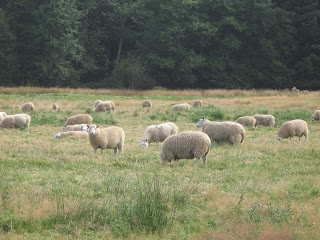“There’s
gold on them thar islands!” or so it seems. With the recent news
of mining claims covering much of the privately owned rural and
agricultural land on North and South Pender, “not in my back yard”
has taken on new meaning. Property owners have been consulting with
legal counsel, elected officials, neighbours and government websites
to try to make sense of it all. Both the Islands Trust and CRD are
conferring with the Ministry of Energy and Mines. It appears that
land with a building, the area around a house, orchards, cultivated
land, heritage land and parks are not included, but that still leaves
large rural areas open to exploration. It surprises many residents
who thought mining of this nature was not allowed in the Gulf
Islands, especially since such activity is counter to the “preserve
and protect” mandate of the Islands Trust.
According
to the Ministry of Energy and Mines, claim staking with Mineral
Titles Online, established in 2005, has been a game changer.
Creating an easy to use online system was intended to streamline the
process, which it certainly did. Mining claims in BC increased
substantially as a result. But there were unintended consequences.
“Online staking now allows claims to be acquired without ever
setting foot on the land. MTO has significantly reduced the cost of
acquiring a claim, and, as a result, has allowed some claims to be
registered by persons who have no intention of ever conducting any
mining activity on the land.”
Although
a property owner’s initial reaction is to prohibit entry of someone
with a free miner’s certificate and claim to the subsurface mineral
rights, the provincial mining laws trump any local laws or private
property owner’s rights. In most cases the province owns the
minerals under the surface, so even if you own the land they own
everything under your land. Property owners should be aware of the
Mining Tenure Act regulations, which require proper notice to be
given and compensation paid to the surface rights property owner.
This can be as simple as an agreement with the miner, or as
complicated as a hearing with the Gold Commissioner or a surface
rights arbitration board.
In the far north corner of the province,
the regional government has helped arrange for a Farmers Advocacy
Office to help landowners through the complicated process with a
compensation arrangement that is as transparent and fair as possible.
The FAO keeps a map and database clearly showing the terms of other
surface rights agreements to help farmers with their own
negotiations. In the case of the grain and forage growing Peace
River area the subsurface resource being extracted is oil and gas,
but the principle is the same.
All
of this harkens back to the gold rush days of the 1800’s. The
earliest regulation of mining in BC came with the Gold Fields
Proclamation of 1859, with the appointment of two gold commissioners
for the Colony of British Columbia. The original Gold Fields “Act”
was to promote land settlement at a time when the province was
sparsely populated and mines were smaller. The establishment of a
Gold Commissioner was to serve as the law in what was a lawless
frontier. It speaks volumes that we still have need of a Gold
Commissioner today, and that we allow our province to continually
tweak an antiquated law that clearly needs an overhaul and an
updating into the 21st century.
The
mining industry in BC is very strong and important to the BC economy.
This fact is certainly not lost on our lawmakers. Perhaps a
complete review is in order, and should include the importance that
mineral and metal recycling may have on the environment and our
economy. It is known that recycling has the advantage of energy
savings and reduced pollution, in addition to the sparing effect on
our environment from reduced mineral exploration. New tools and
research in mining exploration can also reduce the damage to the
surface and water resources and provide a targeted approach to
mining, instead of a shotgun approach of yesteryear
when land was seen as an unlimited resource and miners with no
experience or training could stake claims over large expanses of
land.






_1988.jpg)






























